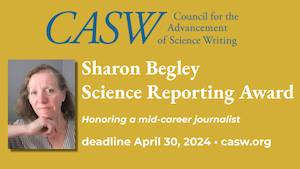By Briley Lewis
The final day of ScienceWriters2021 (#SciWri21) brought a new perspective on science writing, focusing on the history of science in a session titled “How (and Why) to Pitch a 100 Year Old Story.”
Panelists Deborah Blum (@deborahblum, author of The Poisoner’s Handbook), Michelle Nijhuis ([@nijhuism](https://twitter.com/nijhuism/, author of Beloved Beasts), and David Wolman (@davidwolman, author of Aloha Rodeo), along with moderator Betsy Mason (@betsymason), author of All Over the Map), discussed their motivations and experiences writing science history stories.
Using literary and historical approaches to science is, as Blum said, an intriguing kind of “disciplinary trespass.” With these kinds of stories, we’re putting science in the much needed context of history, literature, and culture. One of Blum’s teachers once told her, “You have to take history of science courses, because if you don’t know the history of the field you’re writing in, it’s much easier to be fooled.”
This added context and historical framing better illuminates the present day, Nijhuis added. It also helps readers find their blind spots and oversights, and can prompt scientists to recognize how a legacy is showing up in their own work. Science history stories are also just fun, and non-scientists “can find a lot to dig into” as Nijhuis said. Wolman added that well-written science history stories can bring new people into the conversation, instead of just preaching to the choir of science-interested readers.
The panelists all echoed the same sentiment: a good science history story has interesting people at its core. Blum’s approach is to “get your hero in trouble, and keep them there,” while Nijhuis covered a series of heroes who “passed the baton” to each other throughout history, sometimes even getting in trouble together.
One of the quirks of history stories is that the subjects are often dead—but that shouldn’t deter you from telling their stories. Nijhuis said, “I really found that I loved reporting on dead people.” She described the experience as an interesting challenge, since you know you can never ask them questions directly. Some strategies the panelists offered include talking to the subject’s loved ones, finding handwritten notes and journals of theirs, and visiting places there they had been (even if the events happened a long time ago). Although reporting on dead people can be really fun, the panelists also highlighted the virtues of telling the stories of the living. If someone hasn’t gotten the attention or recognition they deserve, working with them to tell their story can feel like a shared rescue mission.
When asked what she looks for in a science history pitch, Nijhuis asked for a good hook and present day relevance. Wolman reminded the audience, too, that they’re in competition with Netflix and all the other distractions on the internet. “That’s what you have to fight against all the time,” he said. “Don’t be boring.”
Stories can be found in many ways. Nijhuis says “Read widely! Read anything that catches your interest.” Blum similarly recommended to spend time trawling through history, or looking at the arc of scientists’ careers in Google Scholar. Most importantly, don’t assume the story you want to tell has already been done before, since you might be able to find something new or tell the story more comprehensively.
Logistics are also part of making a great science history story: end notes are important, and a fact checker is essential. Historical information can be sourced from traveling to the places where things happened, searching through archives, and talking to amateur historians, local historical societies, graduate students, and librarians. Historical newspapers often feature “delicious language of the time era” as Wolman said, something that can really bring a story alive. Footnotes and smaller news sources, like local newspapers, can also help you find people that may have otherwise been overlooked.
This session generated excitement and inspiration, motivating attendees to explore old stories. As Nijhuis said, “We’re so not done with the past.”
A recording will be available on Whova for #SciWri21 attendees, and anyone can view Tweets from the session with #SciHistoryReporting.
Briley Lewis is a freelance science writer and fourth-year graduate student at UCLA studying Astronomy & Astrophysics. She is also a member of the Astrobites collaboration, contributing author for Massive Science, and organizer for ComSciCon, the communicating science workshop for graduate students. Follow her on Twitter @briles_34 or visit her website www.briley-lewis.com.
Hero image by PublicDomainPictures from Pixabay.

.png)

